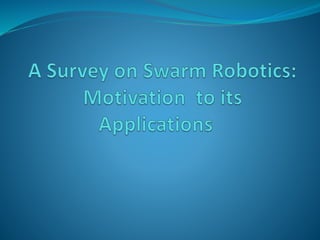
Swarm Robotics Motivation to Inspiration
- 2. What is Swarm Robotics? Yet another novel approach to the control of large group of robots! Study of multi-robot coordination strategies inspired from social insects. Engineering self-organization in physically embodied swarms. Application of Swarm Intelligence to the control of a group of robots.
- 3. What’s novel and desirable in the Swarm Robotics approach? Emphasis on the system-level functioning properties observed in social insect systems: Robustness Flexibility Scalability Essential for deploying large numbers of robots.
- 4. Robustness Social insects can continue to operate despite large disturbances. Redundancy Decentralized coordination Simplicity of the individuals Distributed sensing
- 5. Flexibility Social insects can offer modularized solutions to tasks of different nature by utilizing different coordination mechanisms.
- 6. Flexibility – same swarm, different tasks Foraging Prey retrieval Chain formation
- 7. Scalability Social insects are observed to be able to operate under a wide range of group sizes. That is, coordination mechanisms are rather independent of the number of individuals in the group.
- 8. Finally… a definition Swarm robotics is the study of how large number of relatively simple physically embodied agents can be designed such that a desired collective behavior emerges from the local interactions among agents and between the agents and the environment.
- 9. Criteria for Swarm Robotic systems A swarm robotic system should consist of large numbers of robots, few homogeneous groups of robots, robots that are relatively incapable or inefficient, robots with only local sensing and communication abilities.
- 10. 0 - Individuals should be robots! Individuals should be autonomous robots. Individuals should be situated and autonomous be able to physically interact Mobility of individuals is sufficient, but not required. Metamorphic robotic systems? Yes Sensor networks? No
- 11. 1 - Large number of robots The study should be relevant for the coordination of large numbers of robots. Why relevancy? How large is “large”?
- 12. 2 - Few homogeneous groups of robots The robotic system should consist of few homogeneous groups and that the number of robots in each group should be large. Teams are not swarms. Hierarchical robotic systems (for instance swarms with a “designated queen”) are less `swarm robotic’. What’s a homogeneous group? How about individual adaptation?
- 13. 3 - Relatively incapable of inefficient robots The robotic system should utilize relatively incapable or inefficient robots with respect to the task at hand. The robots should have difficulties in carrying the task on their own. The deployment of a group of robots should improve the performance of system. The deployment of a group of robots should improve the robustness of the system.
- 14. 4 - Robots with only local sensing and communication abilities For coordinating their actions, the robots should utilize only local sensing and communication capabilities. Locality promotes scalability. Existence of global communication channels not used for coordination among the robots does not violate.
- 15. Sources of inspiration Self-organizing natural systems Social insect systems: ants, termites, wasps, bees, cockroaches, locusts… Animals with social behaviors: penguins, birds, fish, sheep... Unicellular organisms: Amoebae, bacteria, viruses… Artificial self-organizing systems Self-assembly of materials
- 16. Aggregation of amoebae into slime mould When food is abundant, amoebae (D. discoideum) acts independently of others, feeding and multiplying (Bonner;1967, Goldbeter;1996). When food supply is depleted amoebae release cAMP ( a chemo-attractant for amoeba) into the extra- cellular environment. Amoebae aggregate forming a slug, a multi- cellular organism which can move and sporulate. Summarized from Self-Organization in Biological Systems by Scott Camazine, Jean-Louis Deneubourg, Nigel R. Franks, James Sneyd, Guy Theraulaz, and Eric Bonabeau
- 17. Quorum sensing in bacteria Bacteria seem to have interesting communication mechanisms to increase their survival. V. fischeri produces light when its population reach a critical size. V. cholarae delays the production of virulence factor until they reach a certain mass, to ensure a successful infection against the infection system. Recent studies show that bacteria use certain auto- inducers to detect their density in the environment. B.L. Bassler, How bacteria talk to each other: regulation of gene expression by quorum sensing. Current Opinions in Microbiology 1999 Dec;2(6):582-7.
- 18. Information exchange in bacteria Bacterial colonies can be more resistant to antibiotics than bacteria living in suspension! Hypothesis: Bacteria form a “genomic web” communicating with each other: Inducive communication: a chemical signal triggers a certain action in other bacteria. Informative communication: the message received is interpreted by the cell, and its response is determined by its history as well as its current state.
- 19. Self-assembly Self-assembly: self-organization by making physical bond formation Individuals lose some of their motility. This creates some interesting dynamics. Social insects and breakable bonds in chemistry Self-assembly of materials is described as the “autonomous organization of components into patterns or structures without [external] intervention.” Whitesides and Grzybowski (Science; 2002) Self-assembly is a promising method for fabricating regular structures: nano-scale self-assembly is promising for building large numbers of micro- electro-mechanical systems (MEMS), improving the robotic assembly processes. 19/29
- 20. Domain Of Application Following are some applications of Swarm Robotics: 1.Tasks that are too dangerous 2.Tasks that cover a region 3.Tasks that scale up or scale down in Time 4.Tasks that require redundandcy
- 21. Conclusion Swarm robotics as a new approach to the control and coordination of multi robot systems. It is supposed that a desired collective behavior emerges from the interactions between the robots and interactions of robots with the environment. The research of swarm robotics is to study the design of robots, their physical body and their controlling behavior.